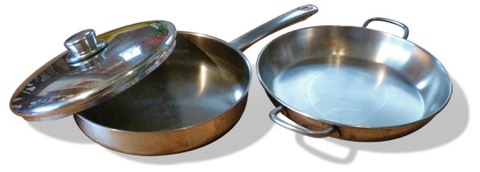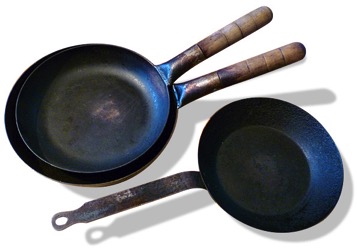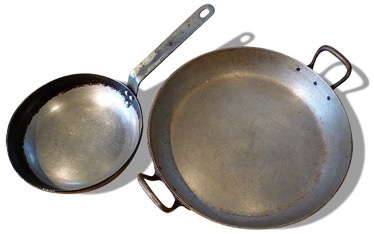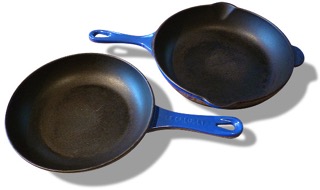Stainless Steel, Aluminium, Carbon Steel or Cast Iron?
What's the best choice of metal for a frying pan?
by Charlie
Back in the mists of time (1986), when Lee and I got together, we decided we should equip ourselves with some decent cookware. Our first investment was in a set of good quality stainless steel saucepans. Twenty-eight years later those pots are still in daily use with virtually no signs of serious wear. At the time we paid nearly £70 for those pans whereas today in the UK, it is possible to purchase a comprehensive set of stainless steel pans for as little as £20!
Stainless Steel Pans
Stainless steel is a great metal for cookware generally, it wears well and looks good but I have one gripe with it. In my opinion it is useless for frying food. Included with our stainless steel pans from the eighties, was a large shiny frying pan, well crafted like all the other pans in the set. The downside is that everything, especially eggs and bacon, stick to it like hell. Lee was most disappointed with it but made a further mistake by replacing it with yet another stainless pan, which she had higher hopes for. Unfortunately the new pan behaved in exactly the way of the former, anything cooked in it stuck!
So what's the deal with stainless steel frying pans and is there a solution? As far as I'm concerned, the only real solution is not to use stainless for frying. The problem lies in the molecular structure of the metal, which is characterised by poor heat conductivity. This leads to uneven temperature across the surface of the metal, which causes the sticking and burning and is also wasteful of energy. The only way to prevent the pan from sticking is to keep it very hot and make sure you use plenty of oil. My recommendation is to switch to carbon steel, aluminium or a non-stick coated alternative.
 Stainless Steel Pans, good looking but cause food to stick and burn.
Stainless Steel Pans, good looking but cause food to stick and burn.Today we have settled on a variety pans to do various different jobs. There are no strict rules, it's just a matter of what seems to work best at the time, then it can become habitual to use that pan again and again. Throughout the years we have expanded our array of cookware on random occasions, mostly when we've spotted something interesting in a charity shop.
Here are my recommendations for choosing a frying pan:

After realising we were out of luck with our stainless steel frying pans, we decided to get an alternative. We opted for an economically priced, rustic looking pan we spotted in a Chinese catering shop. I already had some experience using black iron pans which are popular in France, and already owned a little French pan I used to take with me on camping trips. Carbon steel pans will rust if left in water so need a little care and attention to avoid letting them fall into a poor state. When first purchased, they need to be seasoned by heating them up and rubbing oil and salt into the surface. With regular use a coating will build up, forming its own 'non-stick' characteristics. Black iron pans are perfect for big fry-up breakfasts, where lots of eggs, sausages and bacon are being cooked. Any fats and charred material remaining in the pan can be washed off with ease so the pan can be put back to work immediately. Pans like these are true workhorses and can sustain massive amounts of wear and tear. With minimal maintenance these pans will last a lifetime. Carbon steel pans can be bought from suppliers of authentic Chinese woks such as Hancock or the London Wok company.

A few years ago I picked up a totally unused heavy gauge aluminium omelet pan in a charity shop. It was the first aluminium pan I had used for many years as I had been persuaded to avoid aluminium on account of there being a link with Alzheimer’s decease. Happily such scare stories have been discredited, with absolutely no hard evidence to prove anything either way. So how does aluminium behave in contrast to stainless steel? Extremely well is the answer. Aluminium has spectacularly better thermal conductivity and heat distribution than stainless, and in all the time I've been using this pan I've never known an egg to stick. The downside to aluminium is that it quickly discolours and will never look smart in a fancy modern kitchen. Too bad, looks aren’t everything. Lee has recently acquired another larger French aluminium pan from another charity shop which has fast become a favourite. It looks old and unattractive but with a 30cm width and side handles, it is perfect for use inside the oven as well as on the hob.

Although non-stick pans have a clear advantage, there are distinct downsides too. Anyone who owns a non-stick will be aware, that despite being careful to avoid using hard metal utensils upon the delicate surface coating, sooner or later, it will become worn and scratched. Eventually the non-stick characteristics fade and you will begin to worry about flaking teflon getting into the food? The biggest disappointment I have had is with an expensive heavy gauge 'Circulon' skillet. After only a few years it began to show serious wear despite it being promoted as one of the toughest surfaces of its kind. With a combination of organic material lodged in the pan’s groovy surface, together with fraying material, I decided to donate it to my local dump. The most successful non-stick pans we own were bought for very reasonable prices at a Lidl supermarket. They are mostly used for sautéing large amounts of vegetables and especially good for bubble and squeak. These pans have no special brand names but both have given great service and are still going strong after years. I wouldn't recommend anything else as being much better than these.

I can’t really give a full account of cast iron for frying because my experience is quite limited. Lee, who has been a fan of Le Creuset cast iron cookware since I have known her has mostly used their casseroles for stews or soups. However, some while ago when browsing in yet another charity shop, she bought a small collection of Le Creuset pans for an absurdly small price. Among the items were a couple of little skillets which she has since, as far as I know, used exclusively for cooking fish fillets. Cast iron is a slow conductor but an even distributor of heat. And of course, by the same token, it retains its heat for longer, so is perfect for simmering and slower cooking. One of the advantages of cast iron pans is their ability to be transferred directly from hob to oven.

Chinese cooking is a style that, since the 1980s, has become very popular in the UK. An authentic Chinese wok can be obtained from a Chinese catering supplier but if there are none close to your location search London Wok online. Alternatively most cookware stores or department stores these days will surely stock some other brand. The big wok in the photo is a fantastic piece of kit measuring 36cm across. It was bought in 2003 from a local charity shop for only a couple of pounds. The mid size wok (25cm) at the back has a flat bottom so needs no ring for balance. It was bought in a branch of Wilkos for only £2.50. The smallest one in the front (20cm) was purchased more recently from a specialist supplier for about £8.